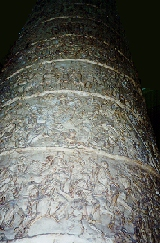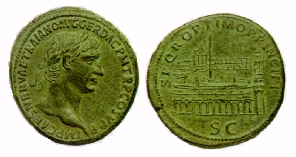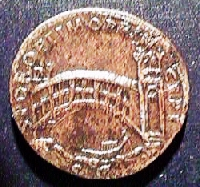Trajan

Emperor, 98 – 117 AD
Born 52 – Died 117 AD, Age 65
Marcus Ulpius Trajanus, was born at Italica in Spain about the year 52 AD. His family was originally from Umbria in Italy. His father, of the same name, was a senator and had served as consul. He was also governor of Asia and Syria at one time. His mother was Marcia, but unfortunately nothing is known of her background.
In Spain, Trajan had an early rigorous military training in the frontier provinces holding several important military posts. Eventually, Trajan was appointed Consul in 91 AD, and was appointed Governor of Upper Germany by the Emperor Nerva. Trajan’s reputation for efficient administration of Upper Germany and support of the military greatly impressed the Emperor Nerva, which had much to do with his adoption by Nerva as the heir to the imperial throne.
 Following the death of Nerva, Trajan’s first goal was to strengthen the frontier defenses between the headwaters of the Rhine and the Danube. Trajan then set out for Rome arriving in the city around 100 AD. He immediately set about strengthening his political power base by winning the support and confidence of the Senate as well as the citizens of Rome itself. Trajan’s good character, wisdom and affable personality aided him greatly in accomplishing that goal. His deep respect for constitutional government and the fairness of law, was quite apparent to everyone.
Following the death of Nerva, Trajan’s first goal was to strengthen the frontier defenses between the headwaters of the Rhine and the Danube. Trajan then set out for Rome arriving in the city around 100 AD. He immediately set about strengthening his political power base by winning the support and confidence of the Senate as well as the citizens of Rome itself. Trajan’s good character, wisdom and affable personality aided him greatly in accomplishing that goal. His deep respect for constitutional government and the fairness of law, was quite apparent to everyone.
After gaining the confidence and support of the people and the Senate, Trajan then began a campaign of territorial expansion. Over a 5 year period, the success of his conquest of Dacia, led to that region becoming a province of the Roman Empire. This conquest was commemorated by his famous column which still stands today in Rome.

Circus Maximus in Rome
Trajan also carried out a substantial building program in Rome including his expansion of the Forum in which Trajan’s Column stands today. He repaired and constructed many roads, bridges, and aqueducts throughout the entire Empire including the Circus Maximus. He also expanded the harbour at Ostia, originally designed by the Emperor Claudius, with a new inner harbour hexagonal in shape.
 Trajan’s Market in Rome
Trajan’s Market in Rome
Trajan’s most important building projects took place during the year 107 AD when he used the spoils from the Dacian conquest to build not merely Trajan’s Forum but also a new market similar to a two story shopping mall of modern time. He also built Trajan’s Baths on the site of Nero’s Golden House and the Naumachia, which was a huge amphitheatre for mock sea battles. In addition, Trajan issued an extensive series of commemorative coins whereby historical issues of the Republic as well as important previous emperors were honored from Julius Caesar to Nerva.
 Danube Bridge
Danube Bridge
Trajan also built the last of the great aqueducts of Rome – the Aqua Traiana. Indeed, Trajan’s building projects were numerous throughout the empire and besides all of these accomplishments, he also built a magnificent bridge across the Danube, which he proudly displayed on his coinage.
During the latter years of his reign, Trajan turned his attention to the eastern frontier focusing directly on the threat presented by the kingdom of Parthia. In 113 AD, Trajan set out to take both Armenia and Mesopotamia. His campaign was again successful adding four new provinces to the Empire. In 115-116 AD, he penetrated into the heart of Parthia itself capturing its capital – Ctesiphon. By this time, revolts broke out in a number of provinces, including Judaea. The Jewish revolt in the east forced Trajan to withdraw from the Syrian capital of Antioch. He successfully put down the Jewish revolt and was then determined to return to Rome to direct operations for a new invasion of Parthia.
According to Cassius Dio, Trajan began to suffer from circulatory problems. He appears to have suffered from a stroke, which left him partially paralysed causing Trajan to suspect poison. Unfortunately, Trajan died en route to Rome at Selinus in Cilicia, during August of 117 AD. Trajan’s Column, which still stands in his expansion known as Trajan’s Forum in Rome, served perhaps as the resting place for his ashes in its base.
Trajan was a model Emperor who was often held in high regard ranked along side of Augustus. By the fourth century, the Senate of Rome still prayed for their emperors using the words “More fortunate than Augustus and better than Trajan.” His reputation as a just, wise and noble leader continued well into the Middle Ages when Dante gave him a place in Paradise.
Historians have always debated whether or not Trajan adopted an heir before he died. Many believe that his wife Plotina may have falsified the adoption of Hadrian, who had always been her favorite at court. The truth of this adoption could not be safely disputed by the Senate, however, and thus the acknowledged heir became Hadrian the next Emperor of Rome.
Correspondence between
Pliny the Younger &
Emperor Trajan
A remarkable pair of documents have survived from the correspondence between the Emperor Trajan and Pliny the Younger who was governor of Pontus/Bithynia from 111-113 AD. The following is a transcript of an exchange between these two famous individuals which offers great insight into the character and wisdom of both men. This exchange between the two men also provides a look into the Christian movement of the time and how it was regarded during the reign of Trajan.
Titles and Powers, 97-117 AD
AD Tribunician Power Imp. Acclamation Consul Other Titles
97 TR.P. CAESAR. GERM.
98 TR.P. (later TR.P.II) – IMP. COS.II. AVGVSTVS. P.M. P.P.
TR.P.III.
99 TR.P.IJI. – 1111.
100 TR.P.tIII. V. COS.III.
101 TR.P.V – VI. IMP.II. COS.IIII.
102 TR.P.VI. – VII. IMP.III. IMP.IIII. DACICVS.
103 TR.P.VII. – VIII COS.V. OPTIMV5 PRINCEPS
104 TR.P.VIII. – VIIII. IMP.V.
105 TR.P.VIIII. X.
106 TR.P.X. – XI. IMP.VI.
107 TR.P.XI. – XII.
108 TR.P.XII. – XIII.
109 TR.P.XIII. – Xliii.
110 TR.P.XIIII. – XV.
111 TR.P.XV. – XVI.
112 TR.P.XVI. – XVII. COS.VI.
113 TR.P.XVII. – XVIII.
114 TR.P.XVIII. – XVIIII. IMP.VII. OPTIMVS.
115 TR.P.XVIIII. – XX. IMP.VIII. – XIII. PARTHICVS.
116 TR.P.XX. – XXI.
117 TR.P.XXI.
Trajan first received his consulship in 91 AD. He received the tribunician power late in 97 AD. For a brief period following his accession, Trajan title remained as TR.P. However, soon afterwards, he decided to continue the dating system on his coinage as established by Nerva (TR.P.II.) and his title thus became TR.P.III. on September 18th, 98 AD. Thereafter, Trajan subsequently renewed his tribunician power each year on that date.
Monetary System

Mints: Rome & Asia Minor
Obverse Legends:
IMP CAES NER TRAJANO OPTIMO AVG GER DAC
IMP CAES NER TRAIANO OPTIMO AVG GER DAC PARTHICO PM TR P COS VI P P
IMP CAES NERVA TRAIAN AVG GERM P M
IMP CAES NERVAE TRAIANO AVG GER DAC PM TR P COS V PP
IMP TRAIANO AVG GER DAC PM TR P
IMP TRAIANO AVG GER DAC PM TR P COS VI PP
DENOMINATIONS
AU Aureus (6.54 grams)
AU Quinarius (4.61 grams)
AR Cistoporus
AR Denarius
AR Quinarius
AE Sesterius
AE Dupondius
AE As
AE Semis
AE Quadrans
The Commemorative (Restored) Coins of Trajan

Commemorative Aureus of Tiberius by Trajan
In this interesting series, issued circa 107 AD, there are restorations of many of the Republican denani as well as aurei beginning with Julius Caesar followed by the Emperors Augustus, Tiberius, Claudius, Galba, Vespasian, Titus and Nerva.
The tradition of honoring previous men in history began during the Republican era when various contemporary men of position would mint coinage displaying the portrait of an honored ancestor. In many ways, such commemorative issues were also an attempt to distinguish themselves as honorable men by publicly displaying their heritage thus legitimizing their current political position.
In the case of Trajan, the extent of this series appears to have been intended to glorify the history of Rome by restoring Republican as well as Imperial coinage of the previous several hundred years.
Monetary System
Mints: Rome
DENOMINATIONS
AU Aureus (6.54 grams)
Julius Caesar
Augustus
Tiberius
Claudius
Galba
Vespasian
Titus
Nerva
AR Denarius (3.54 grms)

830 thoughts on “Trajan – 98-117AD”
Comments are closed.